

Compact Muon Solenoid
LHC, CERN
| CMS-PAS-B2G-17-008 | ||
| Search for top quark partners with charge 5/3 in the single-lepton final state at $\sqrt{s}= $ 13 TeV | ||
| CMS Collaboration | ||
| May 2017 | ||
| Abstract: A search for the pair production of heavy partners of the top quark with an exotic electric charge 5/3 ($X_{5/3}$) decaying into a W boson and a top quark is presented. The search uses data collected in 2016 in proton-proton collisions at a center-of-mass energy of 13 TeV with the CMS detector at the CERN LHC, corresponding to an integrated luminosity of 35.9 fb$^{-1}$. Final states considered include one electron or muon, missing transverse energy, and four or more jets. The $X_{5/3}$ masses with right-handed (left-handed) couplings below 1.32 (1.30) TeV are excluded at 95% confidence level. | ||
| Links: CDS record (PDF) ; inSPIRE record ; CADI line (restricted) ; | ||
| Figures | |
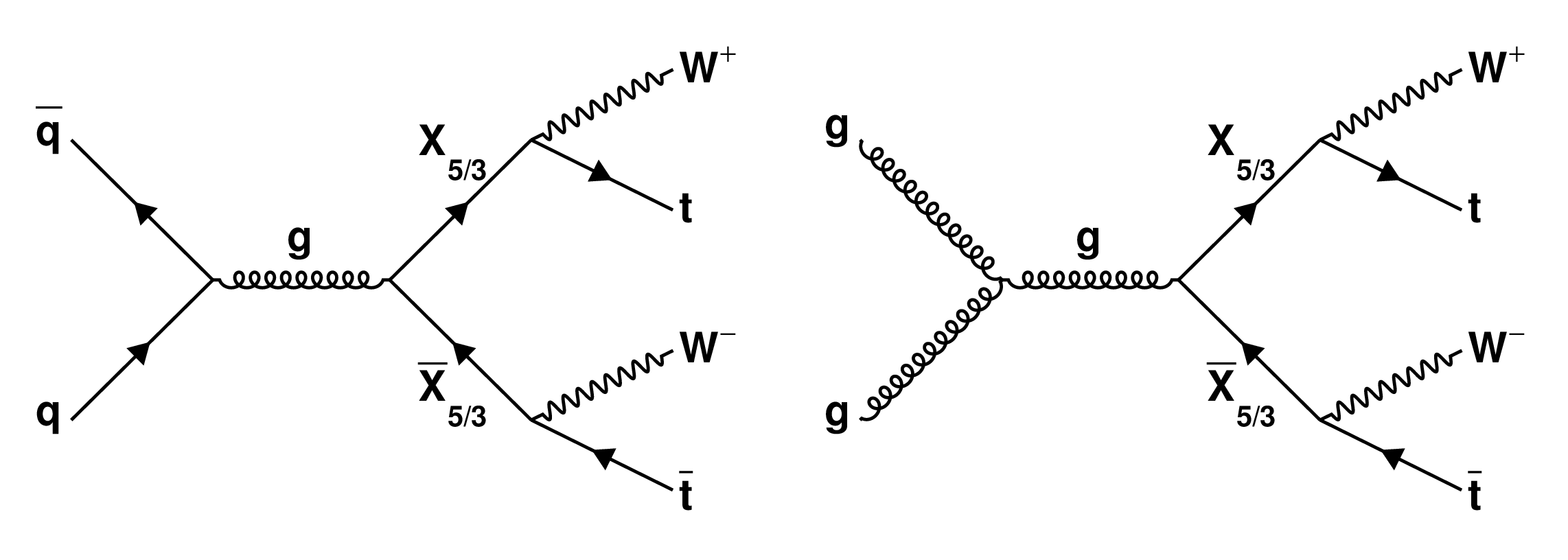
png pdf |
Figure 1:
Leading order Feynman diagrams for the production and decay of pairs of $X_{5/3}$ particles. |
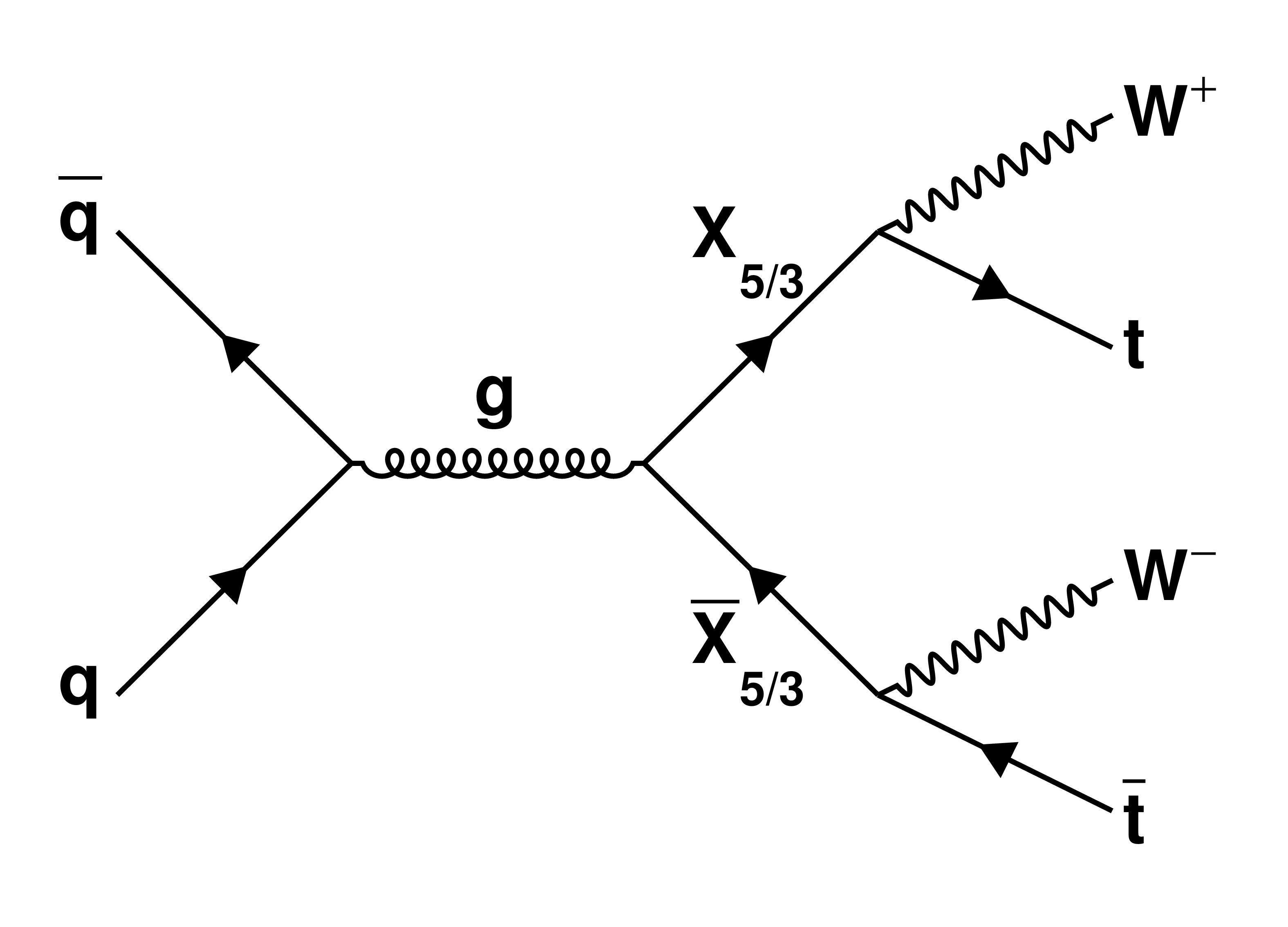
png pdf |
Figure 1-a:
Leading order Feynman diagram for the production and decay of pairs of $X_{5/3}$ particles. |
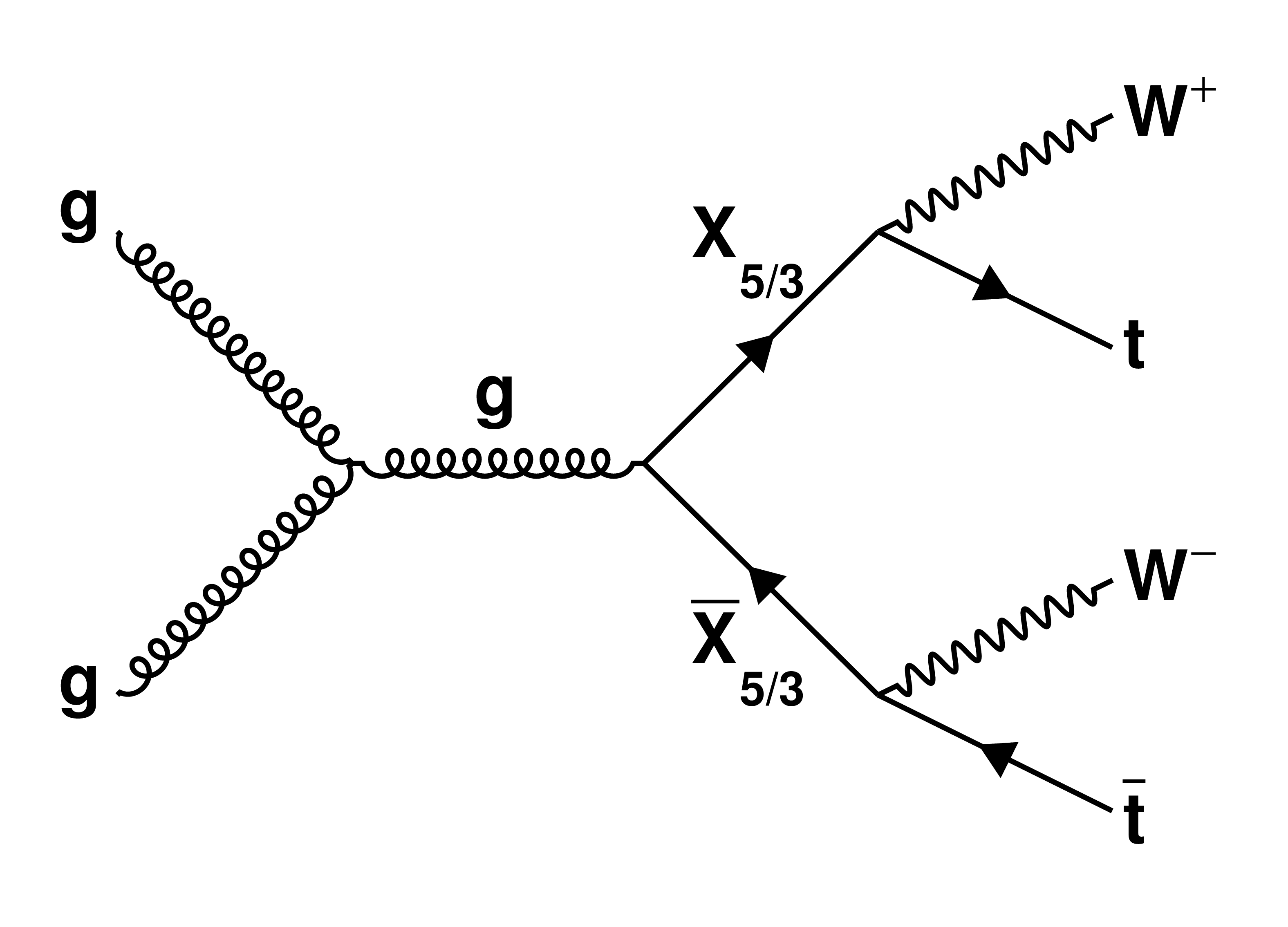
png pdf |
Figure 1-b:
Leading order Feynman diagram for the production and decay of pairs of $X_{5/3}$ particles. |
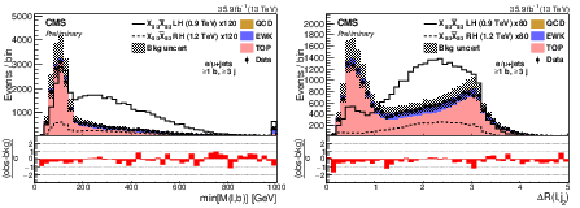
png pdf |
Figure 2:
Distributions of min [M($\ell $, b)] (left) and $\Delta R$($\ell $, $j_{2}$) (right) in data and simulation for selected events with at least three jets and leading AK4 jet $ {p_{\mathrm {T}}} > $ 250 GeV. The events in the overflow bin are added to the last bin of the distributions. The bottom panel on all plots shows the difference between the observed and the predicted number of events in that bin divided by the total uncertainty ($\sigma $). The total uncertainty is calculated as the sum in quadrature of the statistical uncertainty on the observed measurement and statistical and systematic uncertainties on the background. The signal cross sections are scaled by a factor of 120 (80) on the min [M($\ell $, b)] ($\Delta R$($\ell $, $j_{2}$)) distributions in order to make the shape differences between signal and background visible. |
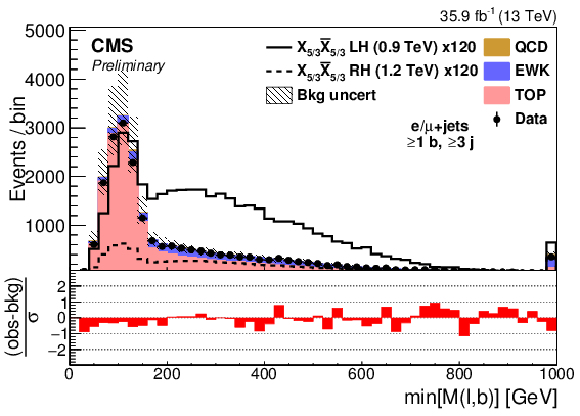
png pdf |
Figure 2-a:
Distribution of min [M($\ell $, b)] in data and simulation for selected events with at least three jets and leading AK4 jet $ {p_{\mathrm {T}}} > $ 250 GeV. The events in the overflow bin are added to the last bin of the distribution. The bottom panel shows the difference between the observed and the predicted number of events in that bin divided by the total uncertainty ($\sigma $). The total uncertainty is calculated as the sum in quadrature of the statistical uncertainty on the observed measurement and statistical and systematic uncertainties on the background. The signal cross sections are scaled by a factor of 120 on the min [M($\ell $, b)] distribution in order to make the shape difference between signal and background visible. |

png pdf |
Figure 2-b:
Distribution of $\Delta R$($\ell $, $j_{2}$) in data and simulation for selected events with at least three jets and leading AK4 jet $ {p_{\mathrm {T}}} > $ 250 GeV. The events in the overflow bin are added to the last bin of the distribution. The bottom panel shows the difference between the observed and the predicted number of events in that bin divided by the total uncertainty ($\sigma $). The total uncertainty is calculated as the sum in quadrature of the statistical uncertainty on the observed measurement and statistical and systematic uncertainties on the background. The signal cross sections are scaled by a factor of 80 on the $\Delta R$($\ell $, $j_{2}$) distribution in order to make the shape difference between signal and background visible. |
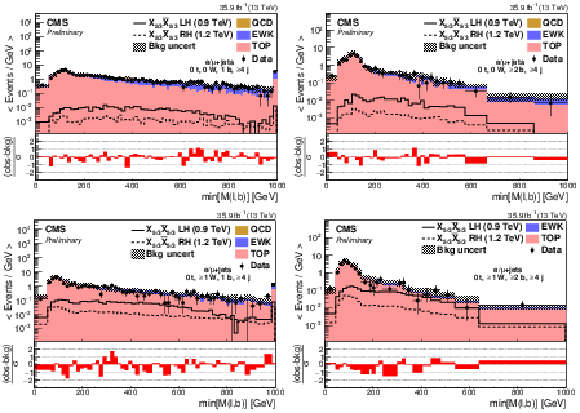
png pdf |
Figure 3:
Distributions of min [M($\ell $, b)] in events with 0 t-tagged jet, (top) 0 or (bottom) $\ge $1 W-tagged jets and (left) 1 or (right) $\ge $2 b-tagged jets for combined electron and muon samples in the signal region. The events in the overflow bin are added to the last bin of the distributions. The distributions are given variable sized bins in each category so that the statistical uncertainty on the total background in each bin is less than 30%. The bottom panel on all plots shows the difference between the observed and the predicted number of events in that bin divided by the total uncertainty ($\sigma $). The total uncertainty is calculated as the sum in quadrature of the statistical uncertainty on the observed measurement and statistical and systematic uncertainties on the background. |
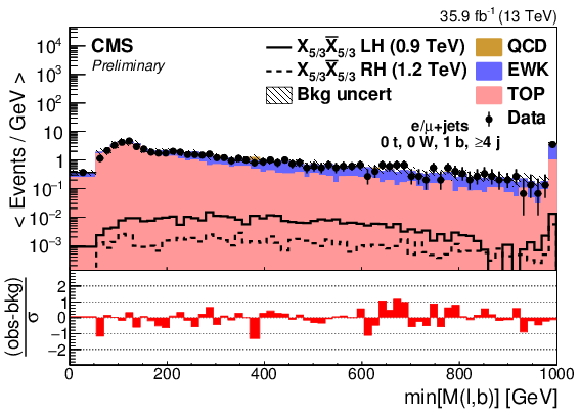
png pdf |
Figure 3-a:
Distribution of min [M($\ell $, b)] in events with 0 t-tagged jet, $\ge $1 W-tagged jets, $\ge $2 b-tagged jets, for combined electron and muon samples in the signal region. The events in the overflow bin are added to the last bin of the distribution. The distribution is given variable sized bins in each category so that the statistical uncertainty on the total background in each bin is less than 30%. The bottom panel shows the difference between the observed and the predicted number of events in that bin divided by the total uncertainty ($\sigma $). The total uncertainty is calculated as the sum in quadrature of the statistical uncertainty on the observed measurement and statistical and systematic uncertainties on the background. |

png pdf |
Figure 3-b:
Distributions of min [M($\ell $, b)] in events with 0 t-tagged jet, (top) 0 or (bottom) $\ge $1 W-tagged jets and (left) 1 or (right) $\ge $2 b-tagged jets for combined electron and muon samples in the signal region. The events in the overflow bin are added to the last bin of the distributions. The distributions are given variable sized bins in each category so that the statistical uncertainty on the total background in each bin is less than 30%. The bottom panel on all plots shows the difference between the observed and the predicted number of events in that bin divided by the total uncertainty ($\sigma $). The total uncertainty is calculated as the sum in quadrature of the statistical uncertainty on the observed measurement and statistical and systematic uncertainties on the background. |
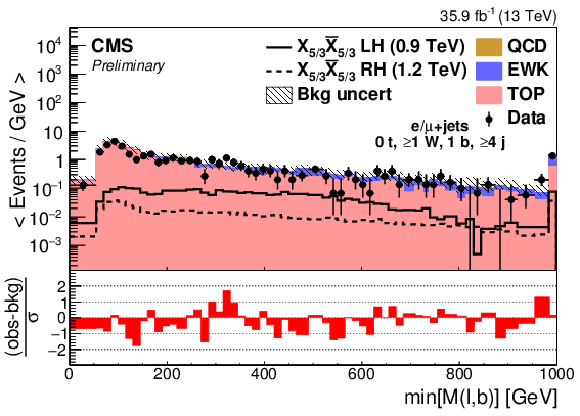
png pdf |
Figure 3-c:
Distributions of min [M($\ell $, b)] in events with 0 t-tagged jet, (top) 0 or (bottom) $\ge $1 W-tagged jets and (left) 1 or (right) $\ge $2 b-tagged jets for combined electron and muon samples in the signal region. The events in the overflow bin are added to the last bin of the distributions. The distributions are given variable sized bins in each category so that the statistical uncertainty on the total background in each bin is less than 30%. The bottom panel on all plots shows the difference between the observed and the predicted number of events in that bin divided by the total uncertainty ($\sigma $). The total uncertainty is calculated as the sum in quadrature of the statistical uncertainty on the observed measurement and statistical and systematic uncertainties on the background. |
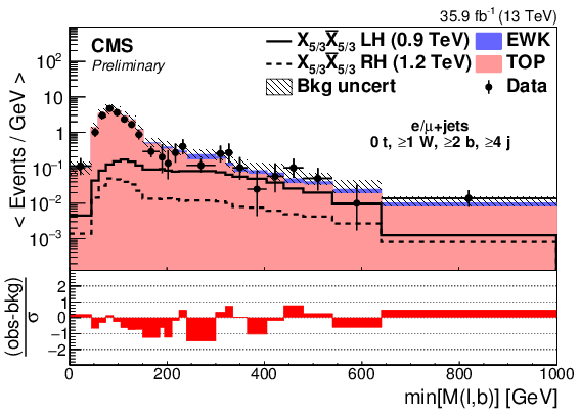
png pdf |
Figure 3-d:
Distributions of min [M($\ell $, b)] in events with 0 t-tagged jet, (top) 0 or (bottom) $\ge $1 W-tagged jets and (left) 1 or (right) $\ge $2 b-tagged jets for combined electron and muon samples in the signal region. The events in the overflow bin are added to the last bin of the distributions. The distributions are given variable sized bins in each category so that the statistical uncertainty on the total background in each bin is less than 30%. The bottom panel on all plots shows the difference between the observed and the predicted number of events in that bin divided by the total uncertainty ($\sigma $). The total uncertainty is calculated as the sum in quadrature of the statistical uncertainty on the observed measurement and statistical and systematic uncertainties on the background. |

png pdf |
Figure 4:
Distributions of min [M($\ell $, b)] in events with $\ge $1 t-tagged jet, (top) 0 or (bottom) $\ge $1 W-tagged jets and (left) 1 or (right) $\ge $2 b-tagged jets for combined electron and muon samples in the signal region. The events in the overflow bin are added to the last bin of the distributions. The distributions are given variable sized bins in each category so that the statistical uncertainty on the total background in each bin is less than 30%. The bottom panel on all plots shows the difference between the observed and the predicted number of events in that bin divided by the total uncertainty ($\sigma $). The total uncertainty is calculated as the sum in quadrature of the statistical uncertainty on the observed measurement and statistical and systematic uncertainties on the background. |
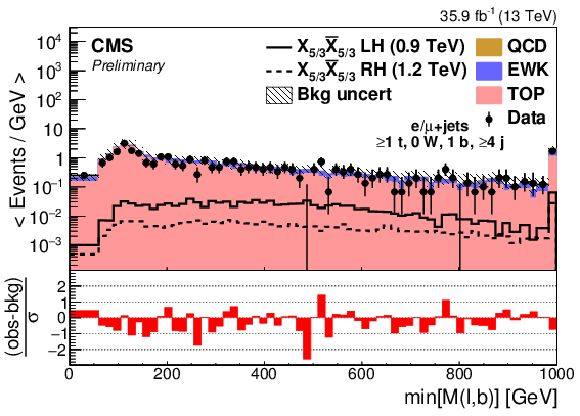
png pdf |
Figure 4-a:
Distribution of min [M($\ell $, b)] in events with $\ge $1 t-tagged jet, 0 W-tagged jet, 1 b-tagged jet, for combined electron and muon samples in the signal region. The events in the overflow bin are added to the last bin of the distribution. The distribution is given variable sized bins in each category so that the statistical uncertainty on the total background in each bin is less than 30%. The bottom panel shows the difference between the observed and the predicted number of events in that bin divided by the total uncertainty ($\sigma $). The total uncertainty is calculated as the sum in quadrature of the statistical uncertainty on the observed measurement and statistical and systematic uncertainties on the background. |
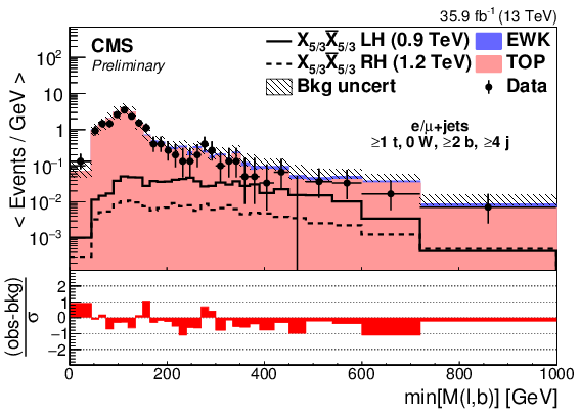
png pdf |
Figure 4-b:
Distribution of min [M($\ell $, b)] in events with $\ge $1 t-tagged jet, 0 W-tagged jet, $\ge $2 b-tagged jets, for combined electron and muon samples in the signal region. The events in the overflow bin are added to the last bin of the distribution. The distribution is given variable sized bins in each category so that the statistical uncertainty on the total background in each bin is less than 30%. The bottom panel shows the difference between the observed and the predicted number of events in that bin divided by the total uncertainty ($\sigma $). The total uncertainty is calculated as the sum in quadrature of the statistical uncertainty on the observed measurement and statistical and systematic uncertainties on the background. |
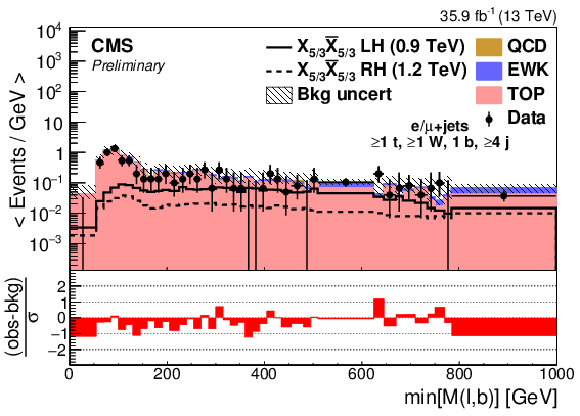
png pdf |
Figure 4-c:
Distribution of min [M($\ell $, b)] in events with $\ge $1 t-tagged jet, $\ge $1 W-tagged jets, 1 b-tagged jet, for combined electron and muon samples in the signal region. The events in the overflow bin are added to the last bin of the distribution. The distribution is given variable sized bins in each category so that the statistical uncertainty on the total background in each bin is less than 30%. The bottom panel shows the difference between the observed and the predicted number of events in that bin divided by the total uncertainty ($\sigma $). The total uncertainty is calculated as the sum in quadrature of the statistical uncertainty on the observed measurement and statistical and systematic uncertainties on the background. |
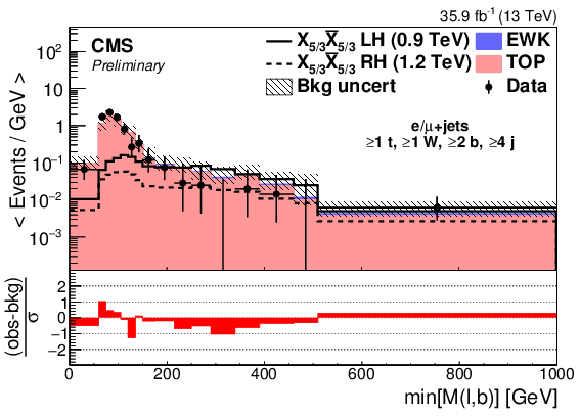
png pdf |
Figure 4-d:
Distribution of min [M($\ell $, b)] in events with $\ge $1 t-tagged jet, $\ge $1 W-tagged jets, $\ge $2 b-tagged jets, for combined electron and muon samples in the signal region. The events in the overflow bin are added to the last bin of the distribution. The distribution is given variable sized bins in each category so that the statistical uncertainty on the total background in each bin is less than 30%. The bottom panel shows the difference between the observed and the predicted number of events in that bin divided by the total uncertainty ($\sigma $). The total uncertainty is calculated as the sum in quadrature of the statistical uncertainty on the observed measurement and statistical and systematic uncertainties on the background. |

png pdf |
Figure 5:
Distributions of min [M($\ell $, b)] in the ${\mathrm{ t } {}\mathrm{ \bar{t} } } $ control region, for 1 b-tagged jet (top left) and $\ge $2 b-tagged jets (top right) categories, and of min [M($\ell $, jets)] in the W + jets control region, for 0 W-tagged (bottom left) and $\ge $1 W-tagged jet (bottom right) categories. Electron and muon event samples are combined. The events in the overflow bin are added to the last bin of the distributions. The distributions are given variable sized bins in each category so that the statistical uncertainty on the total background in each bin is less than $30%$. The bottom panel on all plots shows the difference between the observed and the predicted number of events in that bin divided by the total uncertainty ($\sigma $). The total uncertainty is calculated as the sum in quadrature of the statistical uncertainty on the observed measurement and statistical and systematic uncertainties on the background. |
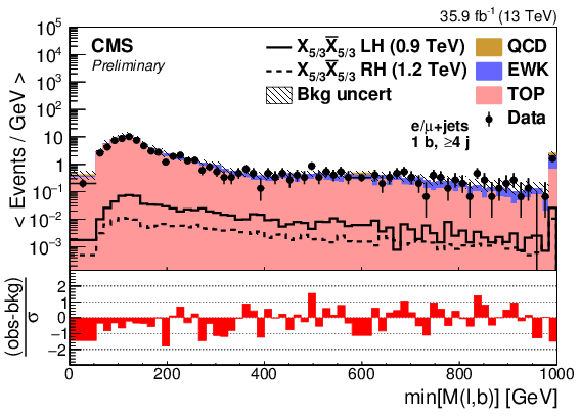
png pdf |
Figure 5-a:
Distribution of min [M($\ell $, b)] in the ${\mathrm{ t } {}\mathrm{ \bar{t} } } $ control region, for the 1 b-tagged jet category. Electron and muon event samples are combined. The events in the overflow bin are added to the last bin of the distribution. The distribution is given variable sized bins in each category so that the statistical uncertainty on the total background in each bin is less than $30%$. The bottom panel shows the difference between the observed and the predicted number of events in that bin divided by the total uncertainty ($\sigma $). The total uncertainty is calculated as the sum in quadrature of the statistical uncertainty on the observed measurement and statistical and systematic uncertainties on the background. |
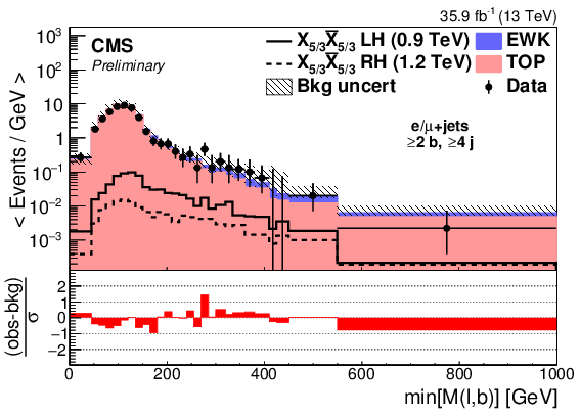
png pdf |
Figure 5-b:
Distribution of min [M($\ell $, b)] in the ${\mathrm{ t } {}\mathrm{ \bar{t} } } $ control region, for the $\ge $2 b-tagged jets category. Electron and muon event samples are combined. The events in the overflow bin are added to the last bin of the distribution. The distribution is given variable sized bins in each category so that the statistical uncertainty on the total background in each bin is less than $30%$. The bottom panel shows the difference between the observed and the predicted number of events in that bin divided by the total uncertainty ($\sigma $). The total uncertainty is calculated as the sum in quadrature of the statistical uncertainty on the observed measurement and statistical and systematic uncertainties on the background. |
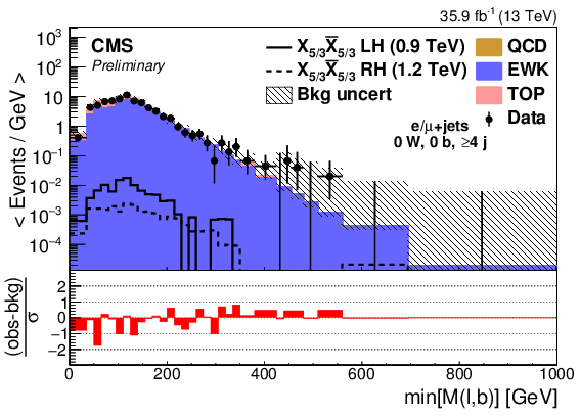
png pdf |
Figure 5-c:
Distribution of min [M($\ell $, jets)] in the W + jets control region, for 0 W-tagged category. Electron and muon event samples are combined. The events in the overflow bin are added to the last bin of the distribution. The distribution is given variable sized bins in each category so that the statistical uncertainty on the total background in each bin is less than $30%$. The bottom panel shows the difference between the observed and the predicted number of events in that bin divided by the total uncertainty ($\sigma $). The total uncertainty is calculated as the sum in quadrature of the statistical uncertainty on the observed measurement and statistical and systematic uncertainties on the background. |
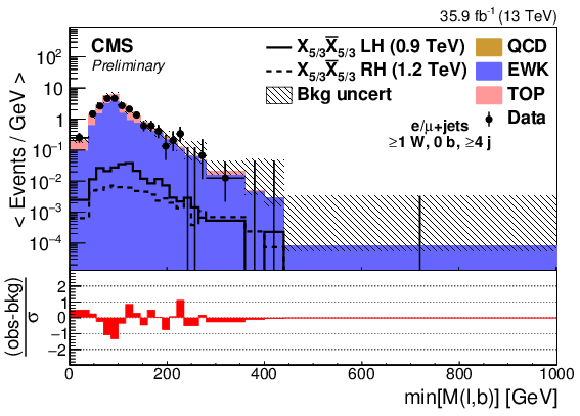
png pdf |
Figure 5-d:
Distribution of min [M($\ell $, jets)] in the W + jets control region, for $\ge $1 W-tagged jet category. Electron and muon event samples are combined. The events in the overflow bin are added to the last bin of the distribution. The distribution is given variable sized bins in each category so that the statistical uncertainty on the total background in each bin is less than $30%$. The bottom panel shows the difference between the observed and the predicted number of events in that bin divided by the total uncertainty ($\sigma $). The total uncertainty is calculated as the sum in quadrature of the statistical uncertainty on the observed measurement and statistical and systematic uncertainties on the background. |
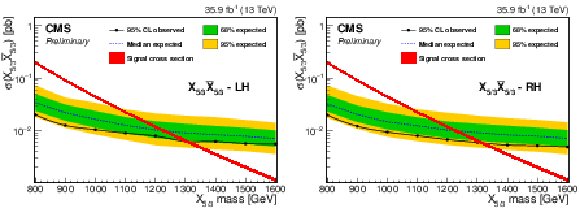
png pdf |
Figure 6:
95% CL expected and observed limits for a left-handed (left) and right-handed (right) $X_{5/3}$ after combining all categories. The theoretical uncertainty on the signal cross section is shown with a band around the theoretical prediction. |
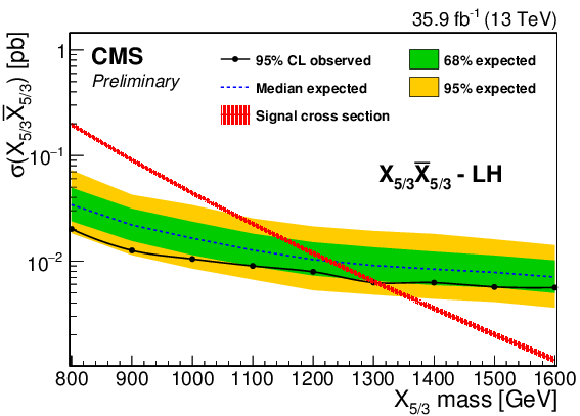
png pdf |
Figure 6-a:
95% CL expected and observed limits for a left-handed $X_{5/3}$ after combining all categories. The theoretical uncertainty on the signal cross section is shown with a band around the theoretical prediction. |
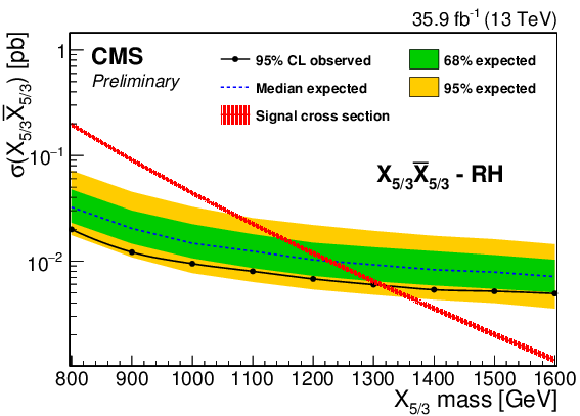
png pdf |
Figure 6-b:
95% CL expected and observed limits for a right-handed $X_{5/3}$ after combining all categories. The theoretical uncertainty on the signal cross section is shown with a band around the theoretical prediction. |
| Tables | |
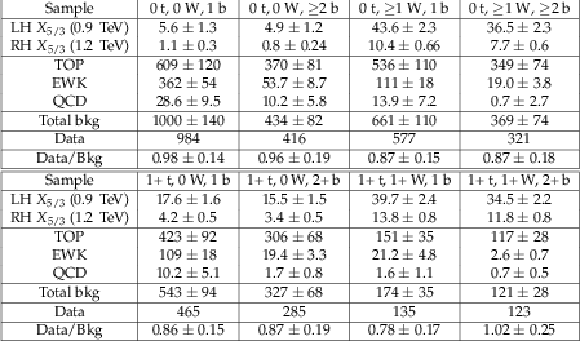
png pdf |
Table 1:
Expected (observed) number of background (data) events passing the final selection requirements, in the signal region ($\Delta R$($\ell $, $j_{2}$) $>1.0$) categories after combining electron and muon channels, with an integrated luminosity of 35.9 fb$^{-1}$. Also shown are the number of expected events for a LH 900 GeV and a RH 1.2 TeV $X_{5/3}$ signals. Uncertainties quoted in the table include both statistical and systematic contributions as listed in Table {tab:sys-error}. |

png pdf |
Table 2:
Expected (observed) number of background (data) events passing the final selection requirements, in the ${\mathrm{ t } {}\mathrm{ \bar{t} } } $ and W+jets control region ($0.4<\Delta R$($\ell $, $j_{2}$) $<1.0$) categories after combining electron and muon channels, with an integrated luminosity of 35.9fb$^{-1}$. Also shown are the number of expected events for a LH 900 GeV and a RH 1.2 TeV $X_{5/3}$ signals. Uncertainties quoted in the table include both statistical and systematic contributions as listed in Table {tab:sys-error}. |

png pdf |
Table 3:
Summary of systematic uncertainties with pre-fit uncertainty ranges. The systematics that affect all the background processes are indicated with "All''. |
| Summary |
| A search for the pair production of heavy partners of the top quark with an exotic charge 5/3 decaying into a W boson and a top quark is presented. The search uses data collected in 2016 in proton-proton collisions at a center-of-mass energy of 13 TeV with the CMS detector at the CERN LHC, corresponding to an integrated luminosity of 35.9 fb$^{-1}$. Final states considered include an electron or a muon, missing transverse energy, and four or more jets. $X_{5/3}$ masses with right-handed (left-handed) couplings below 1.32 (1.30) TeV are excluded at 95% confidence level. |
| References | ||||
| 1 | CMS Collaboration | Observation of a new boson at a mass of 125 GeV with the CMS experiment at the LHC | PLB 716 (2012) 30 | CMS-HIG-12-028 1207.7235 |
| 2 | ATLAS Collaboration | Observation of a New Particle in the Search for the Standard Model Higgs Boson with the ATLAS Detector at the LHC | PLB 716 (2012) 1 | 1207.7214 |
| 3 | A. De Simone, O. Matsedonskyi, R. Rattazzi, and A. Wulzer | A First Top Partner Hunter's Guide | JHEP 04 (2013) 004 | 1211.5663 |
| 4 | G. Dissertori, E. Furlan, F. Moortgat, and P. Nef | Discovery potential of top-partners in a realistic composite Higgs model with early LHC data | JHEP 09 (2010) 019 | 1005.4414 |
| 5 | O. Matsedonskyi, G. Panico, and A. Wulzer | On the Interpretation of Top Partners Searches | JHEP 12 (2014) 097 | 1409.0100 |
| 6 | CMS Collaboration | Search for top-quark partners with charge 5/3 in the same-sign dilepton final state | PRL 112 (2014) 171801 | CMS-B2G-12-012 1312.2391 |
| 7 | ATLAS Collaboration | Analysis of events with $ b $-jets and a pair of leptons of the same charge in $ pp $ collisions at $ \sqrt{s}= $ 8 TeV with the ATLAS detector | JHEP 10 (2015) 150 | 1504.04605 |
| 8 | ATLAS Collaboration | Search for vector-like $ B $ quarks in events with one isolated lepton, missing transverse momentum and jets at $ \sqrt{s}= $ 8 TeV with the ATLAS detector | PRD 91 (2015) 112011 | 1503.05425 |
| 9 | CMS Collaboration | The CMS experiment at the CERN LHC | JINST 3 (2008) S08004 | CMS-00-001 |
| 10 | J. Alwall et al. | The automated computation of tree-level and next-to-leading order differential cross sections, and their matching to parton shower simulations | JHEP 07 (2014) 079 | 1405.0301 |
| 11 | M. Czakon and A. Mitov | Top++: a program for the calculation of the top-pair cross-section at hadron colliders | CPC 185 (2014) 2930 | 1112.5675 |
| 12 | M. Czakon, P. Fiedler, and A. Mitov | The total top quark pair production cross-section at hadron colliders through $ O(\alpha^{4}_{S}) $ | PRL 110 (2013) 252004 | 1303.6254 |
| 13 | M. Czakon and A. Mitov | NNLO corrections to top pair production at hadron colliders: the quark-gluon reaction | JHEP 01 (2013) 080 | 1210.6832 |
| 14 | M. Czakon and A. Mitov | NNLO corrections to top-pair production at hadron colliders: the all-fermionic scattering channels | JHEP 12 (2012) 054 | 1207.0236 |
| 15 | P. Barnreuther, M. Czakon, and A. Mitov | Percent level precision physics at the Tevatron: first genuine NNLO QCD corrections to $ q \bar{q} \to t \bar{t} + X $ | PRL 109 (2012) 132001 | 1204.5201 |
| 16 | M. Cacciari et al. | Top-pair production at hadron colliders with next-to-next-to-leading logarithmic soft-gluon resummation | PLB 710 (2012) 612 | 1111.5869 |
| 17 | P. Nason | A New Method for Combining NLO QCD with Shower Monte Carlo Algorithms | JHEP 11 (2004) 040 | hep-ph/0409146 |
| 18 | S. Frixione, P. Nason, and C. Oleari | Matching NLO QCD computations with Parton Shower simulations: the POWHEG method | JHEP 11 (2007) 070 | 0709.2092 |
| 19 | S. Alioli, P. Nason, C. Oleari, and E. Re | A general framework for implementing NLO calculations in shower Monte Carlo programs: the POWHEG BOX | JHEP 06 (2010) 043 | 1002.2581 |
| 20 | S. Alioli, S.-O. Moch, and P. Uwer | Hadronic top-quark pair-production with one jet and parton showering | JHEP 01 (2012) 137 | 1110.5251 |
| 21 | J. Alwall et al. | Comparative study of various algorithms for the merging of parton showers and matrix elements in hadronic collisions | EPJC 53 (2008) 473 | 0706.2569 |
| 22 | R. Frederix and S. Frixione | Merging meets matching in MC@NLO | JHEP 12 (2012) 061 | 1209.6215 |
| 23 | T. Sjostrand, S. Mrenna, and P. Z. Skands | A Brief Introduction to PYTHIA 8.1 | CPC 178 (2008) 852 | 0710.3820 |
| 24 | T. Sjostrand et al. | An Introduction to PYTHIA 8.2 | CPC 191 (2015) 159 | 1410.3012 |
| 25 | NNPDF Collaboration | Parton distributions for the LHC Run II | JHEP 04 (2015) 040 | 1410.8849 |
| 26 | P. Skands, S. Carrazza, and J. Rojo | Tuning PYTHIA 8.1: the Monash 2013 Tune | EPJC 74 (2014) 3024 | 1404.5630 |
| 27 | CMS Collaboration | Investigations of the impact of the parton shower tuning in Pythia 8 in the modelling of $ \mathrm{t\overline{t}} $ at $ \sqrt{s}=$ 8 and 13 TeV | CMS-PAS-TOP-16-021 | CMS-PAS-TOP-16-021 |
| 28 | $\GEANTfour$ Collaboration | $ Geant 4 $---a simulation toolkit | NIMA 506 (2003) 250 | |
| 29 | J. Allison et al. | Geant4 Developments and Applications | IEEE Trans. Nucl. Sci. 53 (2006) 270 | |
| 30 | CMS Collaboration | Measurement of the differential cross section for top quark pair production in pp collisions at $ \sqrt{s}= $ 8 TeV | EPJC 75 (2015) 542 | CMS-TOP-12-028 1505.04480 |
| 31 | CMS Collaboration | Particle-flow event reconstruction in CMS and performance for jets, taus, and $ E_{\mathrm{T}}^{\text{miss}} $ | CDS | |
| 32 | CMS Collaboration | Commissioning of the particle-flow event with the first LHC collisions recorded in the CMS detector | CDS | |
| 33 | CMS Collaboration | Performance of electron reconstruction and selection with the CMS detector in proton-proton collisions at $ \sqrt{s}= $ 8 TeV | JINST 10 (2015) P06005 | CMS-EGM-13-001 1502.02701 |
| 34 | CMS Collaboration | Performance of CMS muon reconstruction in $ pp $ collision events at $ \sqrt{s}= $ 7 TeV | JINST 7 (2012) P10002 | CMS-MUO-10-004 1206.4071 |
| 35 | M. Cacciari, G. P. Salam, and G. Soyez | The anti-$ k_t $ jet clustering algorithm | JHEP 04 (2008) 063 | 0802.1189 |
| 36 | M. Cacciari, G. P. Salam, and G. Soyez | FastJet user manual | EPJC 72 (2012) 1896 | 1111.6097 |
| 37 | M. Cacciari and G. P. Salam | Pileup subtraction using jet areas | PLB 659 (2008) 119 | 0707.1378 |
| 38 | M. Cacciari, G. P. Salam, and G. Soyez | The Catchment Area of Jets | JHEP 04 (2008) 005 | 0802.1188 |
| 39 | CMS Collaboration | Determination of jet energy calibration and transverse momentum resolution in CMS | JINST 6 (2011) P11002 | CMS-JME-10-011 1107.4277 |
| 40 | CMS Collaboration | Identification of b-quark jets with the CMS experiment | JINST 8 (2013) P04013 | CMS-BTV-12-001 1211.4462 |
| 41 | S. D. Ellis, C. K. Vermilion, and J. R. Walsh | Techniques for improved heavy particle searches with jet substructure | PRD 80 (2009) 051501 | 0903.5081 |
| 42 | A. J. Larkoski, S. Marzani, G. Soyez, and J. Thaler | Soft Drop | JHEP 05 (2014) 146 | 1402.2657 |
| 43 | J. Thaler and K. Van Tilburg | Maximizing Boosted Top Identification by Minimizing N-subjettiness | JHEP 02 (2012) 093 | 1108.2701 |
| 44 | J. Butterworth et al. | PDF4LHC recommendations for LHC Run II | JPG 43 (2016) 023001 | 1510.03865 |
| 45 | T. Muller, J. Ott, and J. Wagner-Kuhr | |||

|
Compact Muon Solenoid LHC, CERN |

|

|

|

|

|

|